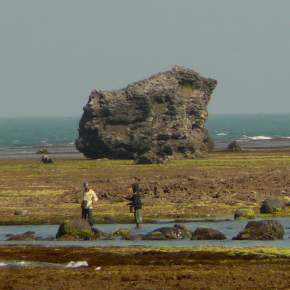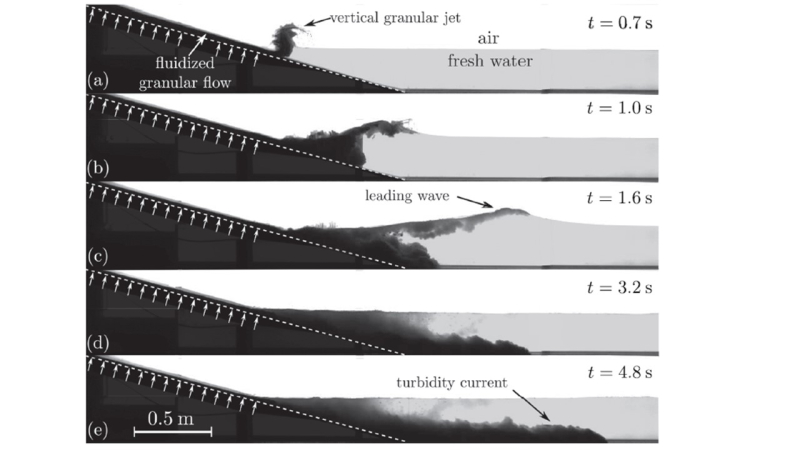Des expériences en laboratoire d’écoulements granulaires fluidisés impactant l’eau mettent en lumière la formation de tsunamis par des écoulements pyroclastiques lors d’éruptions volcaniques explosives proche du littoral.
SOURCE: Journal of Geophysical Research: Solid Earth
Snapshots of a fluidized granular flow entering water, at five different times, after gate opening from which the granular mixture is released. The initial conditions of mass flux, water depth, and slope angle of the inclined plane varied during the experiments. White arrows represent the air flux perpendicular to the inclined plane for the fluidization process. Credit: Bougouin et al. [2020], Figure 2
The sudden displacement of water that commonly generates tsunamis can have various triggering mechanisms. Although earthquake-induced tsunamis are by far the best known, and warning systems are mainly structured to deal with this category, there is a plethora of mechanisms related to volcanic edifices and their activity that are also are able to trigger tsunamis. These include underwater explosions, slope instabilities causing submarine and subaerial landslides, flank and caldera collapses, and pyroclastic flows. All of these make coastal communities living close to active volcanoes particularly vulnerable.
Laboratory experiments carried out by Bougouin et al. [2020] on fluidized granular flows impacting the water after travelling along an inclined plane show how the sustained high gas pore pressure of the mixture ensures the dynamic similarity with natural pyroclastic flows entering the sea. The main characteristics of the generated waves are controlled by mixture dynamics, mass flux and volume of the fluidized granular flow. It is also shown how in the near field region the maximum water depth did not affect wave features and can thus be disregarded.
In addition to the macroscopic dynamics of the process (formation of an initial single vertical granular jet over water followed by the leading wave and by low-amplitude waves, coupled with a turbulent mixing zone forming an underwater turbidity current), it is also shown that grain-size and nature of the moving flow (dry, non-fluidized granular flows, fluidized granular flows or water flows) can unexpectedly play a major role in wave generation.
Citation: Bougouin, A., Paris, R., & Roche, O. [2020]. Impact of fluidized granular flows into water: Implications for tsunamis generated by pyroclastic flows. Journal of Geophysical Research: Solid Earth, 125, e2019JB018954. https://doi.org/10.1029/2019JB018954
Comment les écoulements pyroclastiques génèrent des tsunamis

Bloc de corail arraché du récif, témoin du tsunami généré par les écoulements pyroclastiques du volcan Krakatau en 1883 © Raphaël Paris
Les écoulements pyroclastiques sont des mélanges de gaz et de particules (fragments de lave solidifiée) à haute température provoqués par l’effondrement d’un dôme de lave ou d’une colonne éruptive. Ces écoulements sont très mobiles et peuvent rapidement atteindre des zones situées à plusieurs kilomètres des centres éruptifs. Des exemples récents montrent que des tsunamis volcaniques peuvent être générés lorsque ces écoulements entrent dans la mer (ex. Montserrat 1997 et 2003, Stromboli 2019).
Le nouveau dispositif expérimental construit au LMV (Laboratoire Magmas et Volcans) permet de générer un écoulement granulaire fluidisé qui vient impacter l’eau à grande vitesse. Chaque expérience est filmée à partir de caméras à haute vitesse (250 images par seconde). L’objectif est de déterminer l’influence des différents paramètres dans la génération des tsunamis.
Les expériences menées depuis 2018 confirment que les écoulements pyroclastiques sont particulièrement efficaces en termes de génération de tsunami. En champ proche (zone d’impact de l’écoulement granulaire avec l’eau), les caractéristiques de la vague sont principalement contrôlées par le débit massique et le volume de matériau granulaire entrant dans l’eau, tandis que la profondeur d’eau maximale peut être ignorée. Les vagues générées entrent dans la catégorie des ondes cnoïdales ou ondes de Stokes, ce qui constitue une information importante pour l’évaluation des aléas, et notamment pour le paramétrage des modélisations numériques. La taille de grains utilisée peut également affecter l’amplitude des vagues car elle contrôle la capacité de l’eau à pénétrer dans le matériau granulaire. Les relations mises en évidence permettront à terme de mieux modéliser et anticiper cet aléa volcanique, mais aussi de mieux comprendre les processus physiques complexes entre un écoulement granulaire fluidisé et les autres fluides environnants.


En savoir plus
Alexis Bougouin, Raphaël Paris, Olivier Roche
Impact of fluidized granular flows into water: Implications for tsunamis generated by pyroclastic flows – Journal of Geophysical Research: Solid Earth, 125, e2019JB018954



